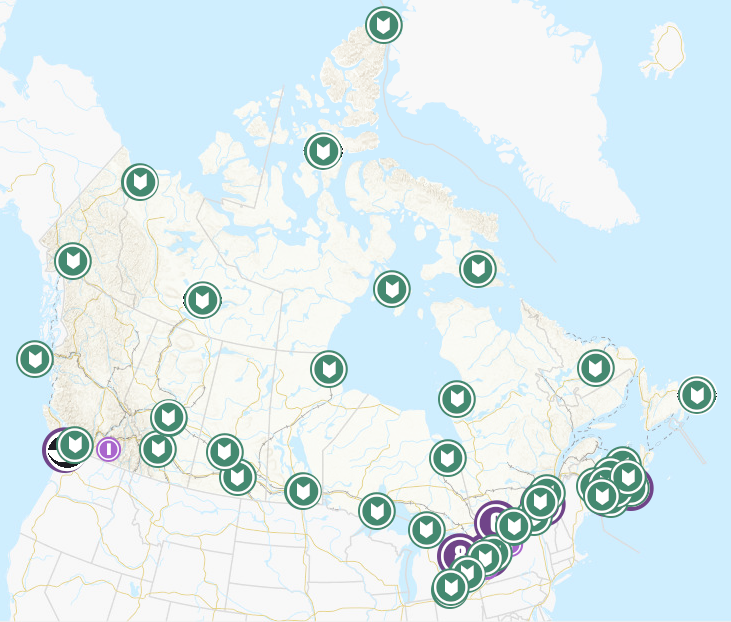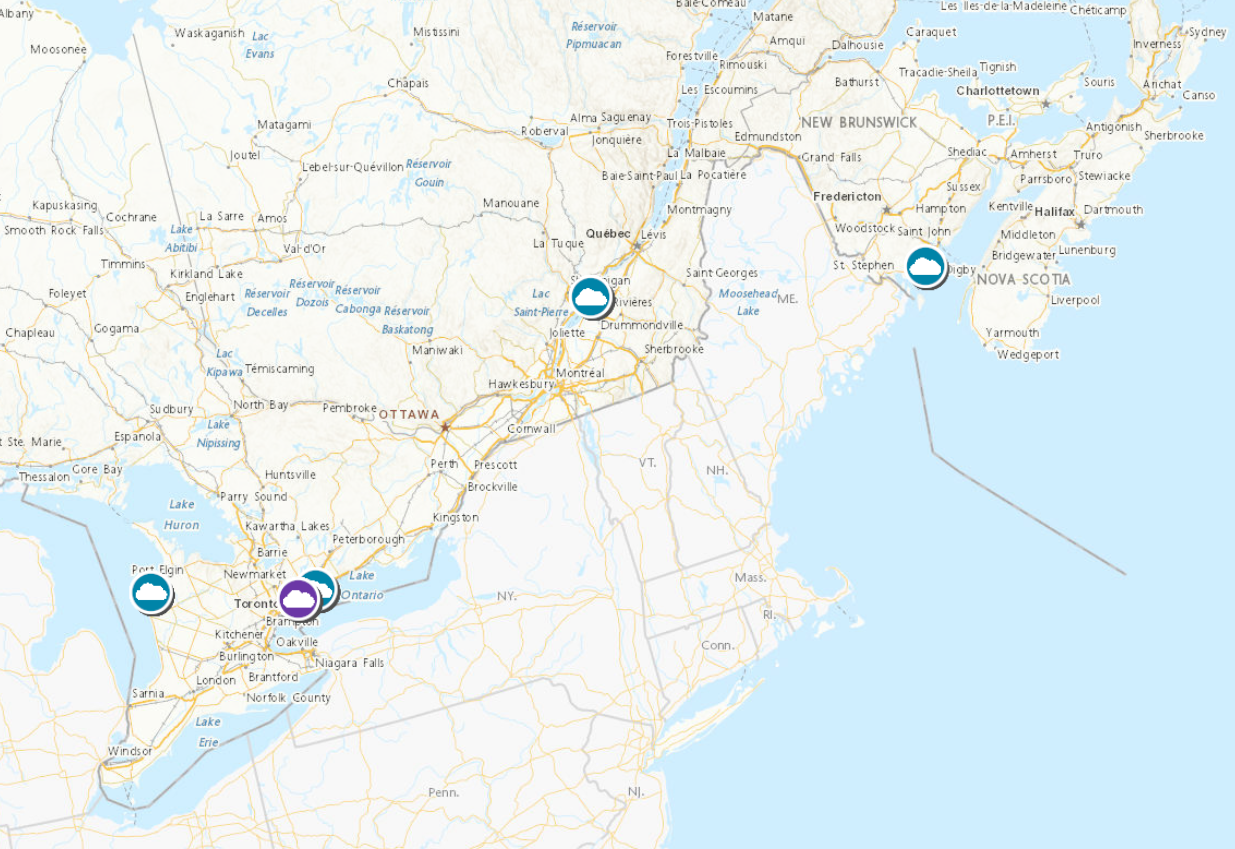Radioactivity
Type of resources
Topics
Keywords
Contact for the resource
Provided by
Formats
Representation types
Update frequencies
status
Resolution
-

The data presented in the radioactivity map of Canada series (Buckle et al., 2014) depict the surface concentrations of three naturally-occurring radioactive elements: potassium (K, %), equivalent uranium (eU, ppm), and equivalent thorium (eTh, ppm); as well as five derived products: natural air absorbed dose rate (NADR, nGy/h) calculated from a linear combination of potassium, equivalent uranium, and equivalent thorium concetrations; the ratios eU/eTh, eU/K, and eTh/K; and the ternary map which uses false colour to illustrate the co-variation of the three measured elements (Broome et al., 1987). This compilation was produced with data from more than 370 airborne gamma-ray surveys flown or supervised by the Geological Survey of Canada between 1969 and 2011. Data was calibrated and acquired in accordance to standards in effect at the time each survey (see Darnley et al., 1975 and IAEA, 1991). Most of the data was acquired using 50 L of Sodium Iodide (NaI) detectors flown at a nominal terrain clearance of 120 m, but line spacings vary from 5000 m to 200 m depending on the specific survey. Potassium is measured directly from the 1460 keV gamma-ray photons emitted by Potassium-40. Uranium and thorium, however, are determined indirectly from gamma-ray photons emitted by daughter products Bismuth-214 (1765 keV) and Thallium-208 (2614 keV) respectively assuming equilibrium between daughter and parent isotopes. For this reason, gamma-ray spectrometric measurements of uranium and thorium are referred to as equivalent uranium (eU) and equivalent thorium (eTh). The measured gamma-rays originate from geological materials in the upper 30 cm of the Earth's surface and their intensity are directly related to the concentrations of K, U and Th in the rocks and minerals present. The geochemical information presented in this compilation is used to support bedrock and surficial geology mapping by outlining lithological variations. It can also indicate mineralization either by association of radio-elements as trace elements with economic minerals or through delineation of their enrichment or depletion due to geochemical alteration resulting from mineralization processes. Overall, this information also contributes to the characterization of the natural radiation environment. Futher information on data acquisition, processing and interpretation and on application can be found in IAEA-TECDOC-1363 (2003), and references therein. These data were also published as Geological Survey of Canada maps, in the Open Files series (7396-7403). References Broome, J., J.M. Carson, J.A. Grant, and K.L. Ford, 1987. A modified ternary radioelement mapping technique and its application to the south coast of Newfoundland, Geological Survey of Canada, Paper 87-14. https://doi.org/10.4095/122382 Buckle, J.L., J.M. Carson, K.L. Ford, R. Fortin and W.F. Miles, 2014, Radioactivity map of Canada, ternary radioelement map, Geological Survey of Canada, Open File 7397. https://doi.org/10.4095/293354 Darnley, A.G., E. M. Cameron and K. A. Richardson, 1975. The Federal-Provincial Uranium Reconnaissance Program, in Geological Survey of Canada, Paper 75-26, p. 49-71. https://doi.org/10.4095/102591 International Atomic Energy Agency, 1991. Airborne Gamma Ray Spectrometer Surveying, International Atomic Energy Agency, Technical Reports Series No. 323. https://www.iaea.org/publications/1427/airborne-gamma-ray-spectrometer-surveying International Atomic Energy Agency, 2003. Guidelines for radioelement mapping using gamma ray spectrometry data; International Atomic Energy Agency, Technical Reports Series No. 1363. https://www.iaea.org/publications/6746/guidelines-for-radioelement-mapping-using-gamma-ray-spectrometry-data
-

This dataset contains the total annual releases of radionuclides released directly to the environment through stack emissions from facilities operated by Canadian Nuclear Laboratories in Canada. This original radionuclide releases dataset of the Canadian Nuclear Laboratories provides results for both stack emissions and direct discharge (i.e. releases to water). The dataset has been divided in two subsets for better discoverability. In this record as its title indicates, you will find the stack emissions results mapped. Make sure to look at the Canadian Nuclear Laboratories direct discharge record in order to obtain a complete picture. Regulatory Oversight Report for Canadian Nuclear Laboratories Sites - 2018: https://nuclearsafety.gc.ca/eng/resources/publications/reports/regulatory-oversight-reports/cnl-report-2018.cfm
-

This dataset contains the total annual releases of radionuclides released directly to the environment through stack emissions from uranium and nuclear substance processing facilities in Canada. This original radionuclide releases dataset of the uranium and nuclear substance processing facilities provides results for both stack emissions and direct discharge (i.e. releases to water). The dataset has been divided in two subsets for better discoverability. In this record as its title indicates, you will find the stack emissions results mapped. Make sure to look at the uranium and nuclear substance processing facilities direct discharge record in order to obtain a complete picture.
-

This dataset contains the total annual releases of radionuclides released directly to the environment through direct discharge (i.e. releases to water) from facilities operated by Canadian Nuclear Laboratories in Canada. This original radionuclide releases dataset of the Canadian Nuclear Laboratories provides results for both stack emissions and direct discharge. The dataset has been divided in two subsets for better discoverability. In this record as its title indicates, you will find the direct discharge results mapped. Make sure to look at the Canadian Nuclear Laboratories stack emissions record in order to obtain a complete picture. Regulatory Oversight Report for Canadian Nuclear Laboratories Sites - 2018: https://nuclearsafety.gc.ca/eng/resources/publications/reports/regulatory-oversight-reports/cnl-report-2018.cfm
-

This dataset contains the total annual releases of radionuclides released directly to the environment through direct discharge from uranium and nuclear substance processing facilities in Canada. This original radionuclide releases dataset of the uranium and nuclear substance processing facilities provides results for both stack emissions and direct discharge (i.e. releases to water). The dataset has been divided in two subsets for better discoverability. In this record as its title indicates, you will find the direct discharge results mapped. Make sure to look at the uranium and nuclear substance processing facilities stack emissions record in order to obtain a complete picture.
-

Health Canada routinely collects environmental samples for radioactivity analysis. The backbone of its monitoring comes from three separate networks: The Canadian Radiological Monitoring Network (CRMN), the Fixed Point Surveillance Network (FPS), and a Canadian contribution to the Comprehensive Nuclear-Test-Ban Treaty Organization (CTBTo). This dataset provides the approximate sampling location of the monitoring stations for each network. CRMN is a national network that routinely collects air particulate, precipitation, external gamma dose, drinking water, atmospheric water vapour, and milk samples for radioactivity analysis. The CRMN has been operating since 1959, and is used to establish long-term trends in naturally occurring environmental radioactivity, nuclear weapons fallout, as well as radioactivity generated by other human activities including nuclear power generation and medical isotope production. Full datasets for the Canadian Radiological Monitoring Network are available on the Open Government Portal. The Fixed Point Surveillance System (FPS) is an integrated network of radiation detectors providing terrestrial gamma radiation measurements in real time. The detectors are located in every province and territory of Canada with larger numbers in the vicinity of major Canadian nuclear facilities and ports where nuclear powered vessels sometimes harbour. Almost real time measurements are available on the EURDEP (EUropean Radiological Data Exchange Platform) website and monthly summaries are provided on the Health Canada website. The Comprehensive Nuclear-Test-Ban Treaty (CTBT) is a universal arms control treaty that bans all States from conducting nuclear explosions in any environment (atmosphere, underground, underwater). Canada is a signatory to the United Nations CTBT. The Radiation Protection Bureau of Health Canada is responsible for four certified radionuclide monitoring stations and a certified radionuclide laboratory. Additional information on the CTBT is available on the CTBTo website. The map shows the approximate sampling location for each monitoring station. Stations are found within the associated location range.
-

This dataset contains the total annual releases of radionuclides released directly to the environment through stack emissions of the nuclear power plants in Canada. This original radionuclide releases dataset of the nuclear power plants provides results for both stack emissions and direct discharge (i.e. releases to water). The dataset has been divided in two subsets for better discoverability. In this record as its title indicates, you will find the stack emissions results mapped. Make sure to look at the nuclear power plants direct discharge record in order to obtain a complete picture.
-

This dataset contains the total annual releases of radionuclides released directly to the environment through direct discharge (i.e. releases to water) from uranium mines and mills in Canada. Note that there is no stack emissions for the uranium mines and mills.
-

This dataset contains the total annual releases of radionuclides released directly to the environment through direct discharge (i.e. releases to water) of the nuclear power plants in Canada. This original radionuclide releases dataset of the nuclear power plants provides results for both stack emissions and direct discharge. The dataset has been divided in two subsets for better discoverability. In this record as its title indicates, you will find the direct discharge results mapped. Make sure to look at the nuclear power plants stack emissions record in order to obtain a complete picture.
-

This dataset contains the total annual releases of radionuclides released directly to the environment through direct discharge (i.e. releases to water) from the closed mine sites near Elliot Lake, Ontario, Canada. Note that there is no stack emissions for the Elliot Lake.
 Arctic SDI catalogue
Arctic SDI catalogue